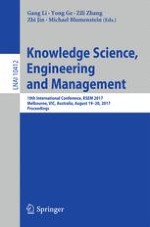
2017 | OriginalPaper | Chapter
Learning Sparse Overcomplete Word Vectors Without Intermediate Dense Representations
Authors : Yunchuan Chen, Ge Li, Zhi Jin
Published in: Knowledge Science, Engineering and Management
Publisher: Springer International Publishing
Activate our intelligent search to find suitable subject content or patents.
Select sections of text to find matching patents with Artificial Intelligence. powered by
Select sections of text to find additional relevant content using AI-assisted search. powered by